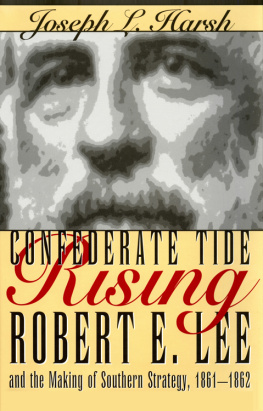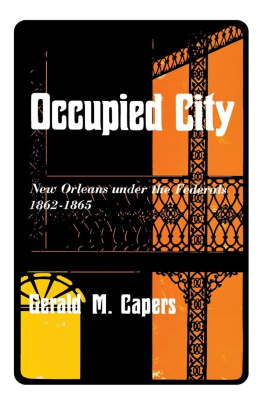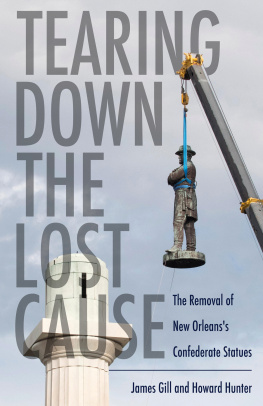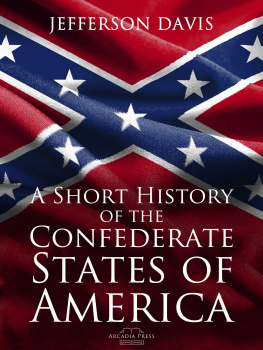Published by Louisiana State University Press
Copyright 1995 by Louisiana State University Press
All rights reserved
Manufactured in the United States of America
Louisiana Paperback Edition, 2005
Designer: Glynnis Phoebe
Typeface: Cochin
Typesetter: Moran Printing, Inc.
Library of Congress Cataloging-in-Publication Data
Hearn, Chester G.
The capture of New Orleans, 1862 / Chester G. Hearn.
p. cm.
Includes bibliographical references (p. ) and index.
ISBN 9780-8071-3070-4 (alk. paper)
1. New Orleans (La.)-History-Capture, 1862. I. Title.
E472.88.H43 1995
973.7'31-dc20
94-39214
CIP
The paper in this book meets the guidelines for permanence and durability of the Committee Production Guidelines for Book Longevity of the Council on Library Resources.

INTRODUCTION
To understand how New Orleans, the Souths largest and greatest city, could be lost to the Union navy as early in the Civil War as it was involves much more than knowing about the passage of two fortifications by Flag Officer David Glasgow Farraguts fleet on the morning of April 24, 1862. The question goes to the heart of government, both Union and Confederate, and the foundation upon which strategic decisions are made. The answer has to do with the way governments select leaders, military and naval, and with the proper employment of resources, human, financial, and natural. If good and bad luck can be eliminated from the equation, the only measurement standard that remains, and the one that must apply, is performance.
The decisions of Jefferson Davis, Stephen R. Mallory, and three different Confederate secretaries of war were as much to blame for the fall of New Orleans as Davy Farraguts warships. The blame, however, fell upon Major General Mansfield Lovell, and to a lesser degree upon Secretary Mallory. Both survived somewhat biased investigations, but Lovells career as a soldier ended the day he pulled his troops out of the Crescent City and handed it back to the mayor to surrender.
In 1860, New Orleans was a gloriously wealthy city, wedded to the South more by geography and cotton than by its inhabitants. A large foreign population had taken root there and settled into careers as shippers and traders. The enormous commerce of the area had attracted families from the North who brought manufacturing, mechanical, and mercantile skills, and capital to invest. Unlike many southern cities, this one was experiencing a decline in slavery. When secession came under discussion, there were those who fought to establish a free city. They wanted to accept protection from the Confederate government but not to be caught in the middle of a war.
Governor Thomas Overton Moore had his own agenda. Louisiana belonged to the South and he would brook no free cities, certainly not a city as important as New Orleans. He carefully orchestrated the secession convention to make certain nothing like that happened. Delegates representing the interests of a meager 5 percent of the public voted Louisiana out of the Union.
After celebrating the victory, Moore turned his attention to protecting what the new Confederate States of America had won: the state of Louisiana. President Davis responded by sending Moore seventy-year-old Major General David E. Twiggs, a man so infirm he could barely get from his hotel to his office at City Hall. Naval Secretary Mallory did slightly better. He sent Commodore Lawrence Rousseau, in his late sixties, to buy or build a navy from scratch. Each had different directives, and neither had the stamina or sufficient cooperation from the other to get much done.
Of the two officers, Rousseau accomplished more during his brief tenure. He bought and started to refit a half dozen ships, but when President Davis offered letters of marque and reprisal to the general public, investors interested in turning a quick profit at the expense of Union shipping purchased every available steamer suitable for privateering. Rousseau was left with the tubs of the waterfront. If the Confederate navy wanted gunboats, they were going to have to build them. But what would they build, and where?
The first priority of General Twiggs concerned the defense of New Orleans, beginning with many needed improvements at Forts Jackson and St. Philip, seventy river miles below the Crescent City. The old forts were armed mostly with small smoothbore cannon from twenty to forty years old. The embrasures, parapets, and surrounding earthworks all required extensive repair. Water batteries, new bombproofs, and sturdier magazines had to be built, along with quarters for the men. For six months, Twiggs talked to his lieutenants but accomplished nothing.
In October, 1861, General Mansfield Lovell, formerly deputy streets commissioner of New York City, replaced Twiggs and found the department in total disarray. Why President Davis chose Lovell was something of a mystery, especially to General Pierre G. T. Beauregard, the Crescent Citys favorite Creole, and Major General Braxton Bragg, who had his home nearby but held an inconspicuous command at Pensacola. The only explanation was Lovells availability and the doubt, at least in Davis mind, that New Orleans was really threatened.
About then, Mallory replaced Rousseau with sixty-two-year-old Commodore George N. Hollins, an independent-thinking sea dog from Maryland who had been in the navy for forty-seven years and still enjoyed a good fight. Although Hollins and Lovell had different instructions, they worked together and shared resources. When Lovell had received his orders for New Orleans, he asked the president for overall command responsibility, which would have included Hollins flotilla, but Davis decided against that. The two departments had to work together, he said, and for a while they did.
Before Beauregard left for a command in Virginia, he gave Twiggs detailed recommendations for the defense of the city. Neither the general nor his second-in-command, Colonel Paul Octave Hebert, seemed actuated by any sense of urgency. Lovell did. He sent crews downriver to improve the forts. They built a strong barrier across the river, replaced old cannons with heavier-caliber rifled guns, and improved water batteries on both sides of the river. Lovell reorganized the command with skilled officers and trained gunners. Around New Orleans and across the river at Algiers he set other crews to digging entrenchments and building emplacements for the stock of old guns the War Department sent to him from Norfolk.
With help from Governor Moore, Lovell recruited, armed, and trained over thirty thousand volunteers specifically for the defense of the lower Mississippi. As the new regiments developed into fighting units, the War Department siphoned them off for duty in Virginia and Tennessee and then asked for more. When Farraguts fleet appeared off the levee at the foot of Canal Street, Lovell had about three thousand militia in New Orleans. Many have asked how Lovell could have let this happen. The reasons were many, but the way the War Department played musical chairs with Lovells regiments and the command confusion Naval Secretary Mallorys actions caused were part of the story.











